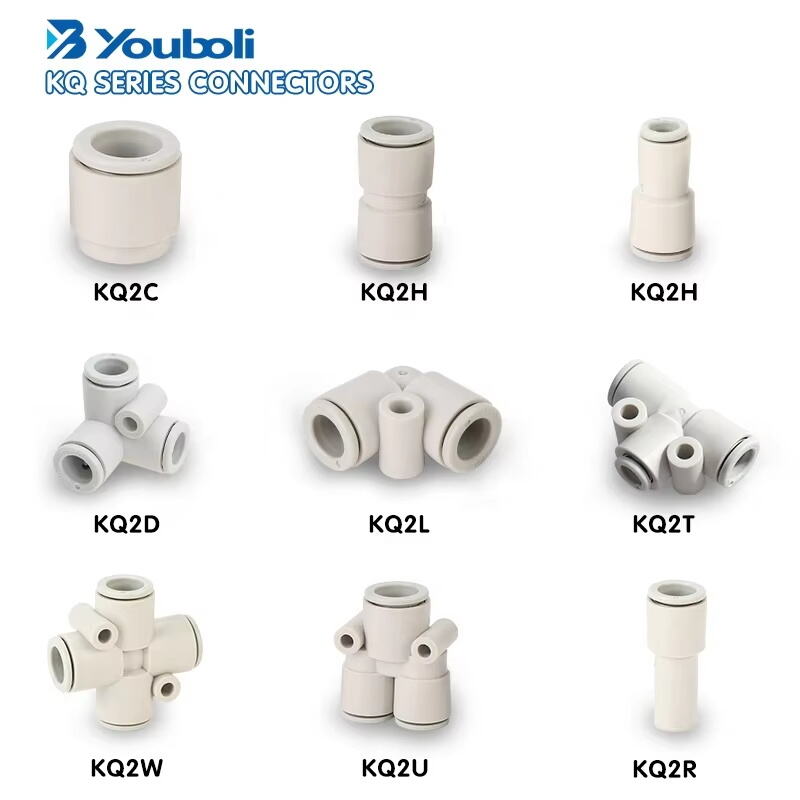Introduction: How Pneumatic Connector Advancements are Driving Automation in Industries
Pneumatic connectors make all the difference in modern industrial automation setups, boosting how efficiently operations run while also pushing forward what's possible in manufacturing. At their core, these connectors act as essential parts of production systems, keeping assembly lines running smoothly without hiccups, cutting down on wasted energy, and minimizing those frustrating machine stoppages that eat into profits. The latest improvements in this tech have really taken off in places like car factories and drug manufacturing plants, where getting things right every single time matters most. For manufacturers trying to stay ahead of the game in today's fast moving production world, keeping tabs on what's new with pneumatic connections isn't just nice to know it's practically table stakes now. Companies that ignore these developments risk falling behind competitors who are already reaping real gains from smarter, faster production processes made possible by better connector technology.
New Materials for Enhanced Durability: Advanced Polymers and Metals Improving Connector Lifespan and Performance
Bringing together advanced polymers and metals in pneumatic connector design has really changed how long they last and how well they perform. What makes these materials stand out is their ability to fight off corrosion and resist wearing down over time, which means connectors just don't break as easily anymore. When manufacturers start using these better materials, their pneumatic systems can handle all sorts of rough conditions that come standard in most industrial settings. Take stainless steel for example it's become pretty much standard across many factories because it stands up against aggressive chemicals without rusting away. Specialized plastics also play a big role here since they maintain integrity even when subjected to constant mechanical stress from day to day operations.
These materials let connectors work even when things get really tough out there, like when they're exposed to super high temps or stuff that eats away at metal. The fact that they can handle all this abuse means the connectors last longer before needing to be swapped out, which makes them much more reliable over time. Research published somewhere called the Journal of Fluid Power showed just how good these materials are for performance improvements. Some tests actually saw connector lifespans jump by around 30 percent because of these material upgrades, which is pretty impressive considering what industrial equipment typically goes through day after day.
Industry veterans working with pneumatic connectors keep coming back to one thing these materials just cant be beat for the job. These components last way longer than alternatives and perform reliably even when things get tough out there on the factory floor. That means less downtime and money saved over time as maintenance needs drop off significantly. With new developments happening all the time in this field, manufacturers who understand what their material options can actually do tend to stay ahead of the curve. Knowing which materials work best where helps fine tune those pneumatic systems so they run smoother and waste less energy day after day.
Smart Connectors for IoT Integration: Pneumatic Connectors with Built-in Sensors and Connectivity for Real-time Monitoring
Smart connectors are changing how things work in the world of IoT, especially when it comes to monitoring pneumatic systems in real time. What makes these connectors so valuable is their ability to keep all parts of an IoT setup talking to each other without any hiccups in the data stream, which ultimately makes everything run smoother and more efficiently. Manufacturing plants that rely on pneumatic equipment are finding these smart connections particularly useful. They get clearer insights into what's happening with their machinery and can adjust operations on the fly rather than waiting for problems to arise. The result? Less downtime and better control over complex industrial processes across different sectors from automotive assembly lines to food processing facilities.
The sensors built into these smart connectors boost performance because they collect important information needed for predictive maintenance work. When something looks like it might go wrong, the system catches it early so problems don't turn into full blown breakdowns. This means less time spent fixing things and lower repair bills overall. Take pressure monitoring as an example. These sensors constantly check what's going on inside the system. If pressure starts acting funny, the equipment sends out warnings long before anything actually breaks down. Technicians get those alerts and can fix whatever needs attention before it becomes a bigger problem.
When companies start using these intelligent connectors, they tend to see better results when it comes to how efficiently operations run and saving money on expenses. Take one major car maker for instance who recently brought in smart pneumatic systems connected to the internet of things. The change cut down on those frustrating stops along the assembly line and lowered what they spend day to day running their factory. Real time monitoring allowed them to tweak production schedules and fix problems before they became big issues. This actually made their machines work harder without breaking down so much. Looking at this case shows just how much difference smart connector tech can make across different manufacturing environments today.
Higher Pressure and Temperature Tolerance: New designs capable of handling extreme industrial environments
Recent improvements in design tech have made a big difference in how pneumatic connectors perform when exposed to high pressure and heat. The latest developments involve using better materials such as stainless steel along with special types of plastic, which makes these parts last longer and work better overall. For instance, some manufacturers now incorporate reinforced polymer coatings that actually stand up to tough conditions while maintaining all necessary functions. These upgrades matter a lot for sectors like oil and gas operations or aircraft manufacturing, where machinery often faces really rough environments day after day. Equipment failures can be costly in these fields, so having reliable connections becomes absolutely essential.
Industries working in harsh conditions stand to gain a lot from these connector advancements. Take oil and gas for example. When those pneumatic connections can handle tougher conditions, it means safer drilling operations and fewer shutdowns. A single point of failure downhole could spell disaster worth millions. The aerospace industry faces similar challenges. Aircraft systems need reliable connections even when dealing with extreme temperature swings and high pressure differentials during flight. What matters most here isn't just running smoother day to day operations, but preventing failures that would ground planes or worse, compromise passenger safety. These improvements make all the difference between routine maintenance issues and potentially dangerous system failures.
The market for connectors capable of handling extreme conditions is expanding fast. Latest data shows the pneumatic components sector will grow substantially over the next few years as manufacturers across various fields require dependable equipment for their demanding environments. Industries ranging from aerospace to automotive manufacturing are pushing for better performance under pressure and heat. Connector technology keeps advancing to meet these requirements, with new designs emerging all the time to address real world challenges faced by engineers working on everything from oil rigs to medical devices. Safety remains paramount in these applications, which explains why so many companies invest heavily in quality connectors despite the costs involved.
Quick-Connect Features for Increased Efficiency: Tools for rapid, leak-free connections reducing downtime.
The quick connect feature on pneumatic connectors really cuts down setup and maintenance time across industrial settings. These connectors are built specifically for fast installations, allowing technicians to create tight, leak free joints in seconds without needing any fancy equipment. The convenience factor is huge for plant managers dealing with tight schedules. Maintenance becomes much less of a headache too since parts can be swapped out quickly during routine checks or emergency repairs. For facilities running complicated machinery arrays, this kind of connector saves both money and downtime when things need fixing or replacing on short notice.
Quick connect fittings make a real difference when it comes to cutting down on downtime and stopping those pesky leaks that plague so many operations. Take manufacturing plants or auto repair shops for instance these days everyone's racing against the clock. These connectors literally shave precious minutes off assembly work and fixes because there's no need to wrestle with traditional fittings anymore. The time saved adds up fast across multiple jobs. What's even better? Systems just run smoother overall since there are fewer chances of leaks causing expensive shutdowns. Many technicians swear by them after switching from old school methods, reporting both faster completion times and fewer headaches dealing with maintenance issues down the road.
Industry pros and actual case studies point to real world gains when companies adopt quick connect tech. Operators across various sectors have noticed they're saving hours on setup times and getting more done overall. Take a factory in Ohio for instance. After installing quick connect pneumatic fittings on their production line, they cut down unplanned stoppages by around 30%. That kind of improvement speaks volumes about how these connectors actually work in day to day operations. The bottom line is that good quality quick connectors aren't just convenient accessories but essential components for keeping factories running smoothly without constant interruptions.
Sustainability in Pneumatic Connector Design: Eco-friendly Materials and Energy-saving Technologies
Green thinking around pneumatic connectors has really taken off lately, especially when it comes to what goes into making them. Manufacturers are turning to materials that actually help the planet instead of hurting it, and these options tend to last longer too. Take a look at what's happening in the industry right now - biodegradable plastics and metal scraps from old parts are showing up more often in connector production lines. These alternatives work just as well as traditional stuff for most applications. What makes this shift important isn't just about checking boxes for regulations either. Companies find they save money long term because these green materials don't break down as quickly, meaning fewer replacements and less downtime overall.
Beyond just using green materials, today's pneumatic connectors are packed with tech that actually cuts down on carbon emissions. The newer models tend to have better pressure management and way fewer leaks, which means less wasted energy overall. For manufacturers, this isn't just good for the environment it also saves money at the end of the month. Most experts agree that we're going to see more of these energy efficient designs hitting the market soon. The whole connector business seems ready for a big change toward sustainability, especially as companies across different industries start looking harder for ways to cut their environmental impact while still keeping costs under control.
FAQ
What are pneumatic connectors?
Pneumatic connectors are components used in machinery to connect different elements of pneumatic systems, aiding in the transfer of energy through pressurized air or gas.
How do smart connectors enhance IoT integration?
Smart connectors provide real-time monitoring through built-in sensors, facilitating seamless communication within IoT ecosystems. This helps in predictive maintenance and operational efficiencies.
Why are advanced materials important in pneumatic connectors?
Advanced materials like specialized polymers and stainless steel enhance the durability and performance of connectors, allowing them to withstand extreme conditions and increasing their lifespan.
Are there eco-friendly options for pneumatic connectors?
Yes, options like biodegradable polymers and recycled metals offer eco-friendly solutions. These materials reduce environmental impact while maintaining efficiency and performance.
Table of Contents
- Introduction: How Pneumatic Connector Advancements are Driving Automation in Industries
- New Materials for Enhanced Durability: Advanced Polymers and Metals Improving Connector Lifespan and Performance
- Smart Connectors for IoT Integration: Pneumatic Connectors with Built-in Sensors and Connectivity for Real-time Monitoring
- Higher Pressure and Temperature Tolerance: New designs capable of handling extreme industrial environments
- Quick-Connect Features for Increased Efficiency: Tools for rapid, leak-free connections reducing downtime.
- Sustainability in Pneumatic Connector Design: Eco-friendly Materials and Energy-saving Technologies
- FAQ

